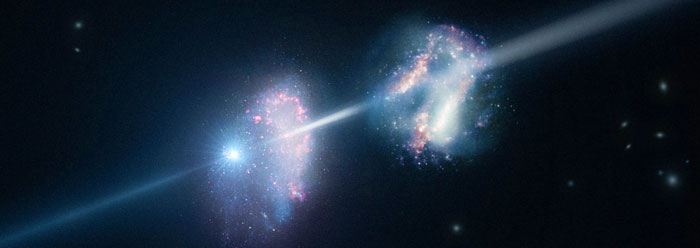"These galaxies have more heavy elements than have ever been seen in a galaxy so early in the evolution of the Universe. We didn't expect the Universe to be so mature, so chemically evolved, so early on," said German researcher Sandra Savaglio, lead author of a related paper slated to appear in Monthly Notices of the Royal Astronomical Society.1
A core Big Bang doctrine is that certain stars process lighter elements into heavy elements. The Big Bang supposedly only produced the lightest elements, hydrogen and helium. Astronomers speculate that after millions of years, hydrogen clouds condensed into stars. And then eons passed before those stars became mature enough to create the heavier elements, all of which astronomers call "metals." But stars never could have formed this way, and these new observations fly in the face of that doctrine.2
Instead of immature and lightweight galactic elements in these very distant galaxies, "the emerging picture is that the spread in metallicity is large at any redshift [distance]," according to the authors.3 The researchers analyzed the gamma-ray burst spectral lines, which showed that the galaxies through which the ray traveled contained more metals than the sun.
Distant galaxies appear just as mature as those near to earth, as though there was no relative time difference between the galaxies' formation. For example, very distant spiral galaxies—where stars are arranged in great, winding arms—appear to have undergone the same amount of spiral arm winding as closer ones. This is consistent with the idea that astronomical time runs, or used to run, at very different rates than earth time.4 It also matches the proposed idea that distant starlight takes no time to travel to earth.5
Astronomers routinely find mature-looking galaxies at great distances, and these galaxies defy the Big Bang's story of how nature might have constructed them, as well as when they were formed.6
Why do these galaxies have such mature makeups? The Big Bang could not have produced stars or galaxies, but would instead have produced evenly scattered material.7 Therefore, since the very existence of stars and galaxies requires a supernatural cause, it stands to reason that the same Cause would have also determined the composition of those stars and galaxies.
References
- VLT Observations of Gamma-ray Burst Reveal Surprising Ingredients of Early Galaxies. Max Planck Institute for Extraterrestrial Physics news release, November 2, 2011.
- DeYoung, D. 1996. New Stars, New Planets? Acts & Facts. 25 (4).
- Savaglio, S. et al. 2011. Super-solar Metal Abundances in Two Galaxies at z ~3.57 revealed by the GRB090323 Afterglow Spectrum. Monthly Notices of the Royal Astronomical Society. Published online before print October 19, 2011.
- Humphreys, R. How do spiral galaxies and supernova remnants fit in with Dr. Humphreys' cosmological model? Creation Ministries International. Posted on creation.com, accessed November 17, 2011.
- Lisle, J. 2010. Anisotropic Synchrony Convention—A Solution to the Distant Starlight Problem. Answers Research Journal. 3: 191-207.
- Thomas, B. 'Old' Galaxy Found in 'Young' Part of the Universe. ICR News. Posted on icr.org May 24, 2011, accessed November 17, 2011.
- Coppedge, D. 2007. Inflating the Evidence. Acts & Facts. 36 (12): 15.
Image credit: ESO/L. Calçada
* Mr. Thomas is Science Writer at the Institute for Creation Research.
